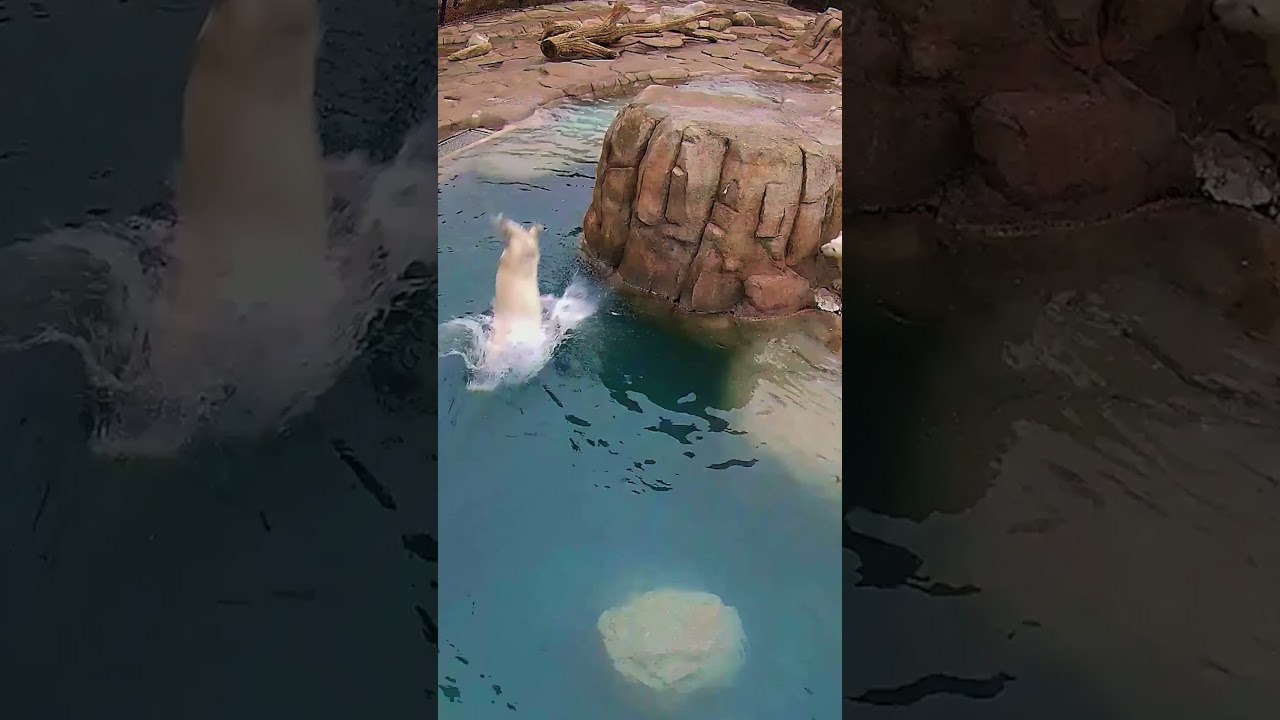– The enchanting world of Polar Bear Cubs: A deep dive into their playful antics and the importance of jumping in their physical and cognitive development.
– Kallik and Kallu: An intimate look at the bond between two polar bear siblings at Toledo Zoo and their passion for leaping.
– Polar Bear Enrichment: How zoos like Toledo Zoo create dynamic environments that stimulate and mimic natural behaviors in polar bears and visitors’ role in this process.
A hop, a skip, and a giant leap are few sights more captivating than polar bear cubs bounding with unabashed joy in their exhibit, particularly at the Toledo Zoo, where the young residents Kallik and Kallu have captured the hearts of many with their frolicsome escapades.
Their vitality is far more than a source of endearment, though. Jumping, a common play behavior in many young animals, including polar bears, is key to these cubs’ physical development and well-being. As we delve into this frolicking delight, we’ll explore the joy these magnificent creatures exhibit and the crucial role such activities play in their survival, both in captivity and the wild.
First, it’s essential to understand why these magnificent mammals, the world’s largest land carnivores, engage in such playful behavior. In the wild, jumping can be tied to several crucial survival skills. It helps develop strong muscles and bones, agility, and coordination – all necessary for traversing the rocky terrains and sea ice they call home.
Furthermore, jumping and other playful actions are pivotal during a polar bear’s formative years. It’s a time for learning and honing hunting techniques, establishing social hierarchies, and developing cognitive abilities through interactive experiences with siblings and their environment. For instance, the playful tussling and mock fighting often seen among cubs are rehearsals for more serious confrontations they may encounter later in life within the icy realms of the Arctic.
At the heart of Toledo Zoo’s polar bear exhibit, the vigorous leaps and bounds of Kallik and Kallu become a wonderful illustration of what enrichment looks like in a zoo setting. Enrichment, in the context of zoological environments, refers to anything that promotes natural behavior, encourages physical activity, and stimulates mental processes – essentially anything that elevates the quality of life for these animals.
Zoos and aquariums accredited by the Association of Zoos and Aquariums are mandated to develop comprehensive enrichment programs for the animals in their care. This commitment reflects a growing understanding of animal welfare and the complexities of keeping wild animals healthy and engaged in a captive environment.
Kallik and Kallu’s love for jumping reflects the success of such enrichment endeavors. The environment where they play and explore is crafted with care, using state-of-the-art design to simulate aspects of their natural habitat. Strategically placed platforms of varying heights and materials allow the young cubs to leap and pounce to their hearts’ content.
This isn’t just important for their physical development; it’s also a testament to the cognitive enrichment provided by problem-solving opportunities inherent in their environment. Figuring out how to navigate their space, climb and jump from one area to another, stimulates their brains like the mental challenges they would encounter in the wild.
Moreover, this playful activity is central to the bond between siblings Kallik and Kallu. It serves as a social glue, strengthening their interactions and cooperation skills. Visitors can gain a heartwarming glimpse into the deep familial ties fundamental to these magnificent creatures by watching them leap together, chase each other, and share moments of playful contact.
It’s also worth mentioning that enrichment isn’t a one-way street; it’s not just about what humans provide for the animals. Visitors to the zoo themselves play a part in this dynamic. The presence of people around the exhibit can enrich the bears, arousing their curiosity and presenting new stimuli.
However, it’s critical to strike a balance. Close attention is paid to ensure that interactions between animals and visitors remain healthy and don’t cause undue stress. But when done right, as at Toledo Zoo, the symbiotic relationship between animal and observer becomes an enriching experience for both.
There’s a deeper significance to the zoo’s role and the activities of the bear cubs: conservation awareness. In the wild, the status of polar bears is increasingly threatened by climate change, with the loss of their sea ice habitat jeopardizing their future. By engaging the public with the captivating antics of Kallik and Kallu, zoos can foster a connection between people and these distant animals, catalyzing much-needed attention and concern for their plights.
These play sessions are also invaluable to scientific study. By observing the behavior of cubs like Kallik and Kallu in a controlled environment, researchers can gain insights into the nuances of polar bear behavior that may be difficult to discern in the wild. This knowledge, in turn, feeds back into conservation strategies.
This blend of education, empathy, and scientific inquiry forms the underpinning philosophy of modern zoological institutions like Toledo Zoo. In providing a safe, engaging, and rich habitat for these animals, they serve a role far greater than mere spectacle; they become living classrooms, conservation hubs, and windows into worlds that many may never have the chance to witness firsthand.
As we contemplate the leaps of Kallik and Kallu, it’s easier to understand why these play acts are the threads weaving together the tapestry of their development, survival, and understanding. It demonstrates how something seemingly simple – the joy of two polar bear cubs jumping – is significant in animal wellbeing, education, and the broader conservation narrative.
In conclusion, the delightful displays of Kallik and Kallu are not just adorable vignettes. They are a strong reminder of the intrinsic value of these sentient beings and an emblem of the critical work done by zoos globally to ensure that future generations can continue to witness the truly wondrous expressions of life on our shared planet.
*****
Source Description
Kallik and Kallu love jumping in their exhibit!
https://www.toledozoo.org/


